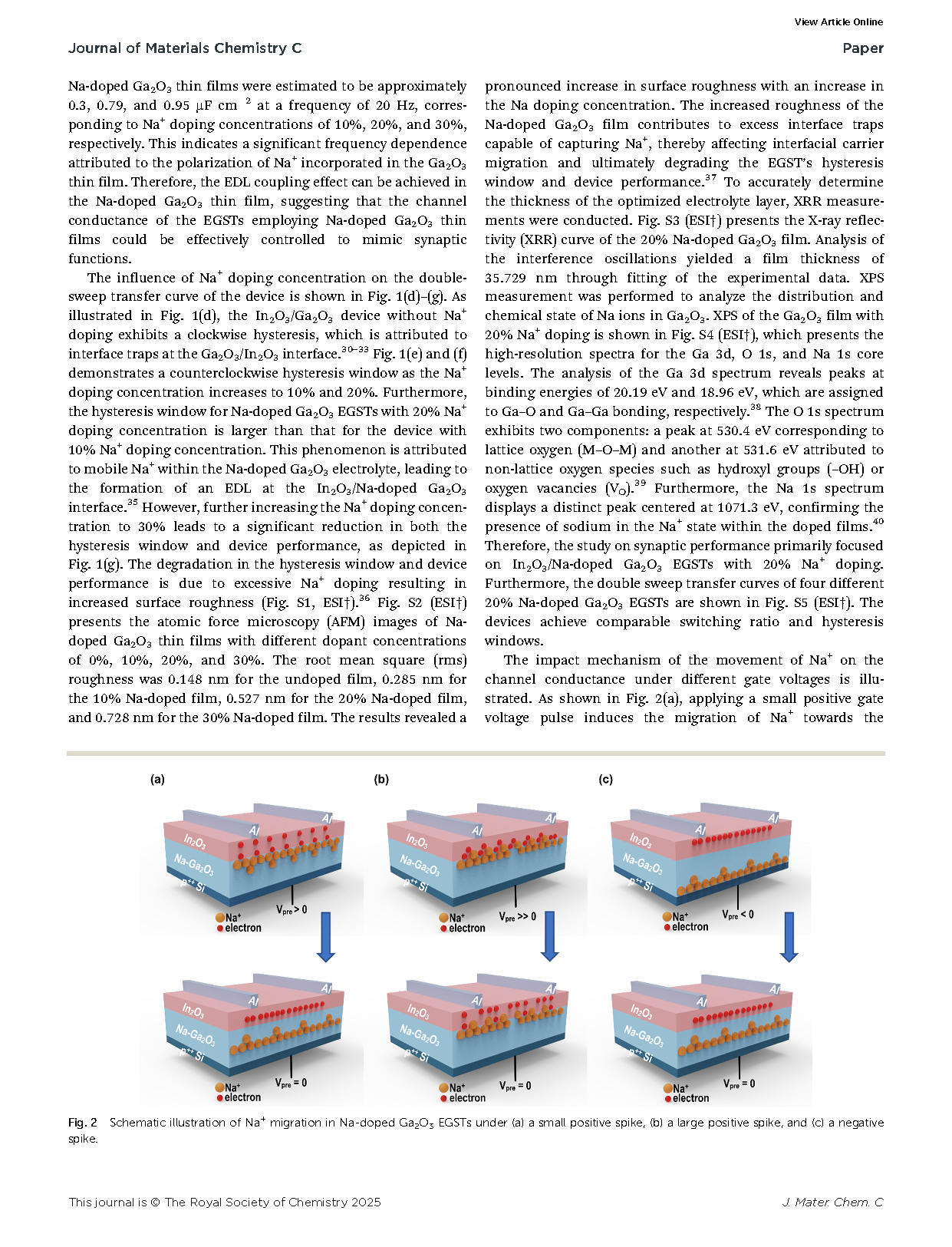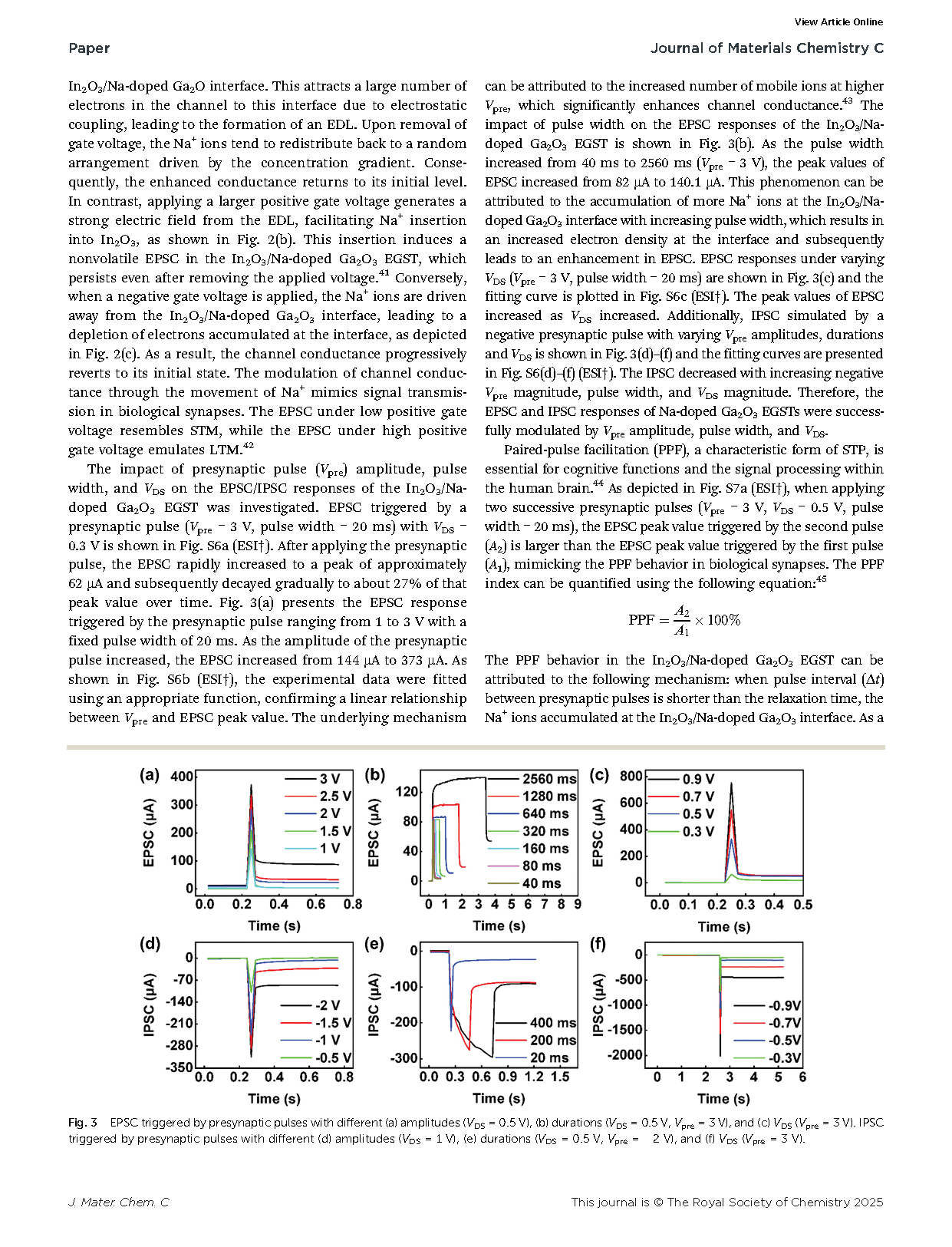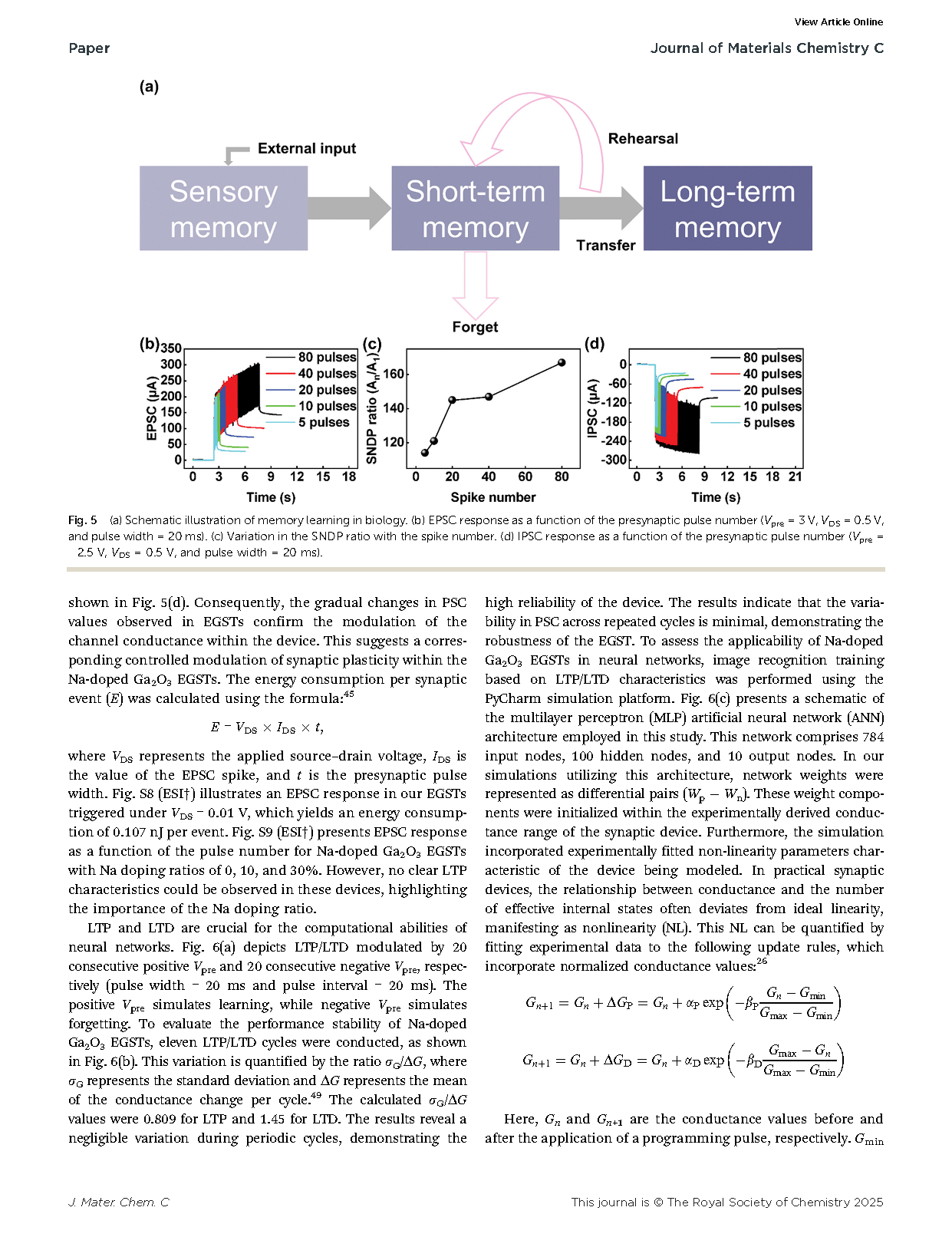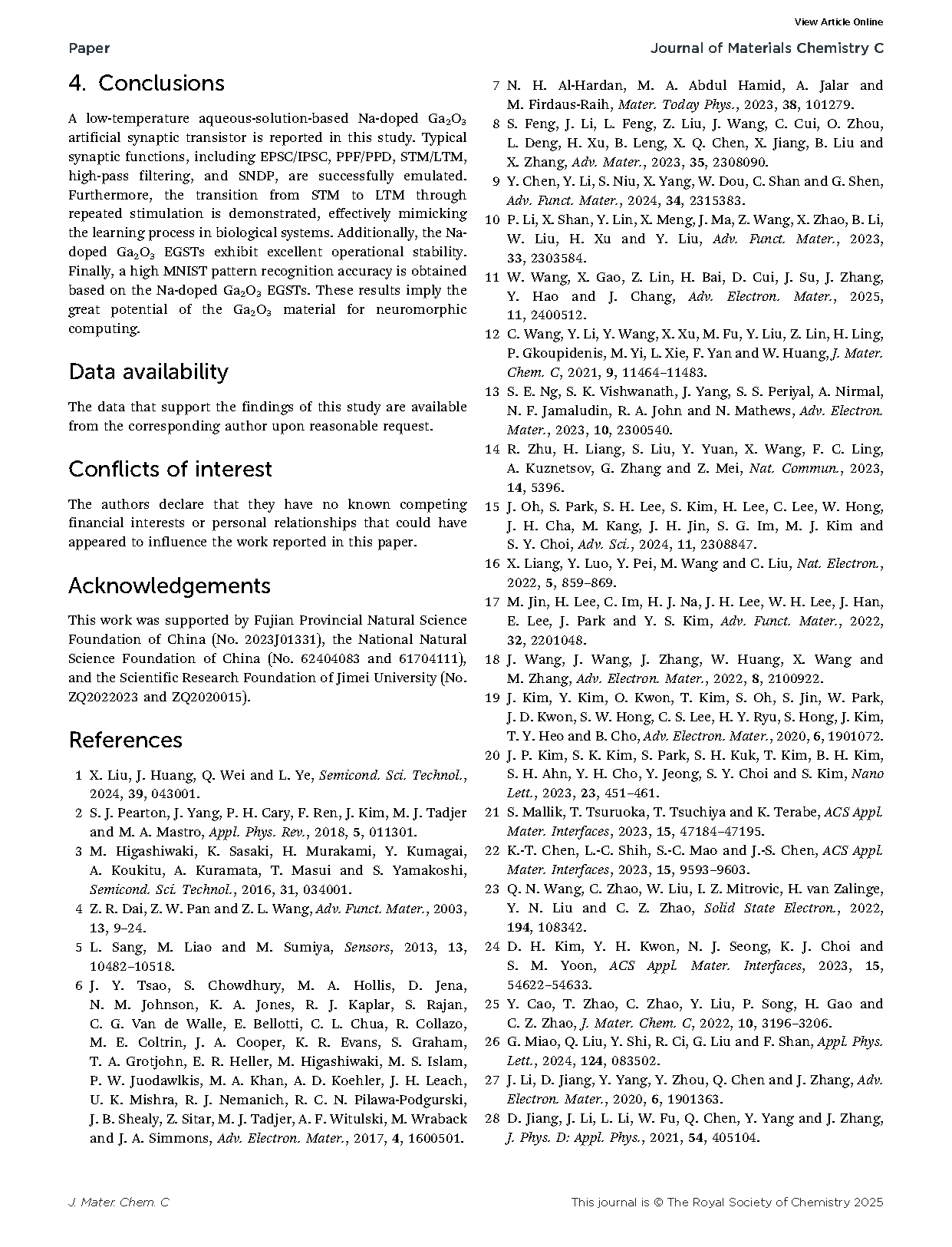

【Domestic Papers】Jimei University---Na-doped Ga₂O₃ electrolyte-gated synaptic transistors for neuromorphic computing
日期:2025-06-18阅读:328
Researchers from the Jimei University have published a dissertation titled "Na-doped Ga₂O₃ electrolyte-gated synaptic transistors for neuromorphic computing" in Journal of Materials Chemistry C.
Background
Neuromorphic computing, as a new computing paradigm that aims to break through the bottleneck of the traditional von Neumann architecture, has put forward an urgent need for electronic devices that can efficiently simulate biological synaptic functions. Among the many candidate materials, gallium oxide (Ga₂O₃) has shown emerging application potential in the field of building artificial synaptic devices due to its ultra-wide bandgap, excellent chemical stability and unique optoelectronic properties. However, previous neuromorphic research based on Ga₂O₃ has mainly focused on two-terminal memristor structures. When simulating complex synaptic functions, such devices face inherent challenges such as sneak path current, poor functional controllability and difficulty in large-scale integration. To address these limitations, researchers have turned their attention to three-terminal synaptic transistors, aiming to achieve precise dynamic regulation of device conductance by introducing an independent control terminal (gate). As an important device for simulating biological synaptic functions, three-terminal synaptic transistors, especially electrolyte-gated synaptic transistors (EGSTs), modulate the channel by the migration of ions under an electric field. Its working mechanism is highly similar to that of biological synapses, and it shows great potential in achieving high-fidelity synaptic plasticity. Studies have shown that by doping Ga₂O₃ materials with ions (such as sodium ions in this article), their function as an electrolyte can be effectively regulated, thereby accurately simulating a variety of synaptic behaviors from short-term memory to long-term memory, opening up new avenues for building high-performance, low-power neuromorphic systems.
Abstrct
The neurobionic properties and working mechanism of the sodium ion (Na⁺) doped gallium oxide (Ga₂O₃) three-terminal electrolyte-gated synaptic transistor prepared by a low-temperature aqueous solution method were systematically studied. The study adopted a comprehensive electrical testing method, including capacitance-frequency (C-f) measurement, pulse response analysis and artificial neural network (ANN) simulation, to clarify the modulation mechanism of sodium ion migration on channel conductance and its key role in simulating biological synaptic plasticity. The results show that moderate sodium ion doping (20%) can make the Ga₂O₃ layer exhibit significant electrolyte properties. Under an applied electric field, the migration and redistribution of ions form a strong double electric layer (EDL) coupling effect, which is the core of realizing synaptic function. The device successfully simulated a variety of key biological synaptic behaviors, including excitatory/inhibitory postsynaptic currents (EPSC/IPSC), short-term/long-term memory (STM/LTM), pulse pairing plasticity (PPF/PPD) and high-pass filtering. In addition, by regulating the frequency and number of presynaptic pulses, the study achieved a smooth transition from short-term memory to long-term memory and achieved a high accuracy of 87.8% in the MNIST handwritten digit recognition simulation. This work not only verifies the effectiveness of the sodium ion doping strategy, but also provides an innovative design idea and a solid experimental foundation for the development of low-cost, high-performance gallium oxide-based neuromorphic computing devices.
Innovation
A three-terminal electrolyte-gate-controlled synaptic transistor based on sodium-ion-doped gallium oxide (Na-Ga₂O₃) was reported for the first time.
Innovatively use the migration of Na⁺ ions under electric fields to simulate the signal transmission and memory function of biological synapses.
Comprehensive simulation of multiple key synaptic plasticities, including short-term memory (STM), long-term memory (LTM), and the transition between the two. The high performance of the device was verified in artificial neural network simulations, with an accuracy rate of 87.8% in handwritten digit recognition, demonstrating its great application potential in the field of neuromorphic computing.
A low-cost, low-temperature (250°C) aqueous solution preparation process was achieved, which has good environmental friendliness and process compatibility.
Conclusion
In this study, an electrolyte-gated synaptic transistor based on sodium-doped gallium oxide (Na-Ga₂O₃) was successfully prepared by a low-temperature aqueous solution method, and its neuromorphic computing function and intrinsic physical mechanism were systematically explored to clarify the modulation effect of sodium ion migration under an electric field on the synaptic plasticity of the device. The results show that by precisely controlling the doping concentration of sodium ions, the electrolyte properties of the Ga₂O₃ layer can be effectively regulated, thereby achieving accurate simulation of the channel conductance. The analysis of electrical characteristics shows that the device successfully simulates a variety of key biological synaptic functions, including excitatory/inhibitory postsynaptic currents (EPSC/IPSC), short-term/long-term memory (STM/LTM), and pulse pairing plasticity (PPF/PPD). High-resolution electrical pulse tests further confirmed that by changing the amplitude, width, and frequency of presynaptic pulses, the synaptic weight (i.e., channel conductance) can be finely regulated, and the learning process of switching from short-term plasticity to long-term plasticity can be simulated. Finally, based on the neural network simulation of experimental data, the device showed an accuracy of up to 87.8% in the MNIST handwritten digit recognition task, verifying its application potential in complex pattern recognition. This comprehensive study not only proposed a novel device structure and material system, but also laid a solid foundation for the development of low-cost, high-performance, and environmentally friendly neuromorphic computing hardware. These findings greatly expand the application prospects of gallium oxide materials in the field of advanced computing and provide important scientific guidance for the design of a new generation of smart electronic devices.

Fig. 1. (a) Schematic diagram of biological synapse. (b) Device architecture of Na-doped Ga2O3 EGSTs. (c) C-f characteristics of Al/Na-doped Ga2O3/p++ Si MIM devices with different Na doping concentrations. The transfer curves of Na-doped Ga2O3 EGSTs with different Na doping ratios of (d) 0%, (e) 10%, (f) 20%, and (g) 30%.
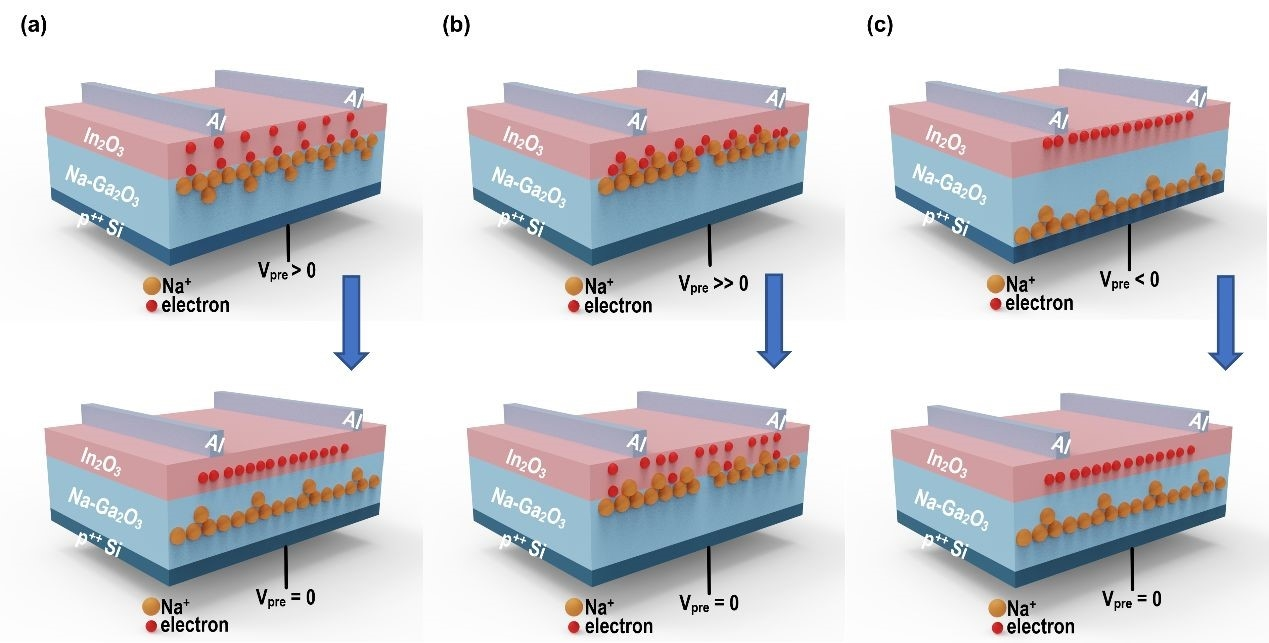
Fig. 2. Schematic demonstration of Na+ migration in Na-doped Ga2O3 EGSTs under (a) a small positive spike. (b) a larger positive spike, and (c) a negative spike.
DOI:
doi.org/10.1039/D5TC01248A


